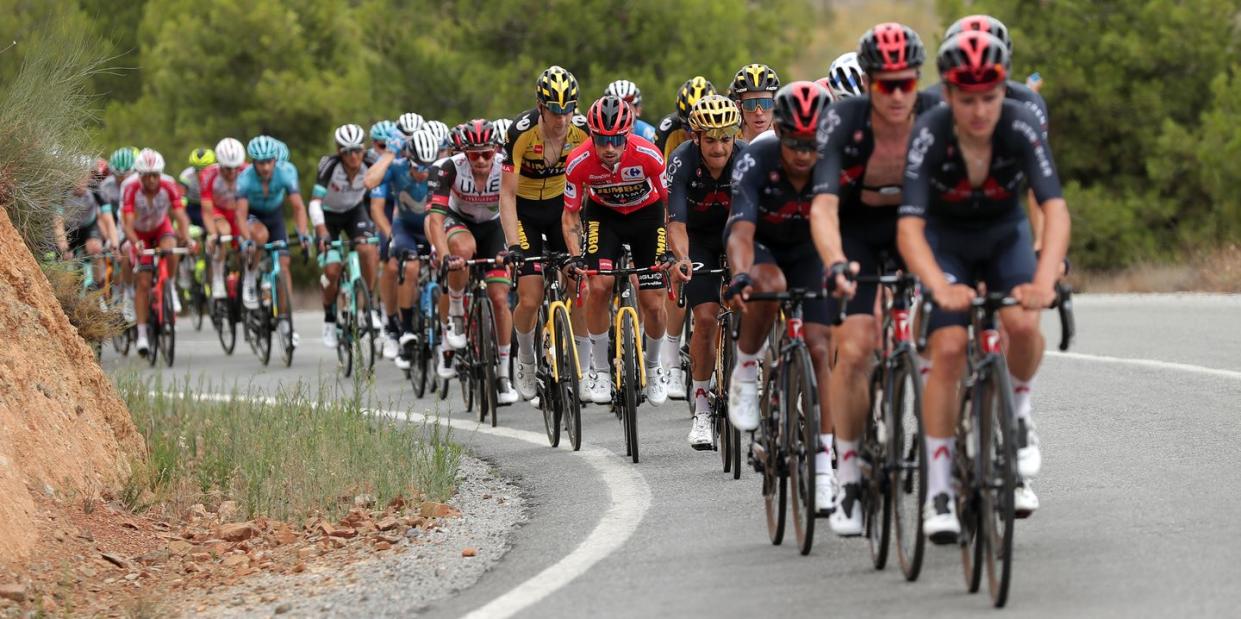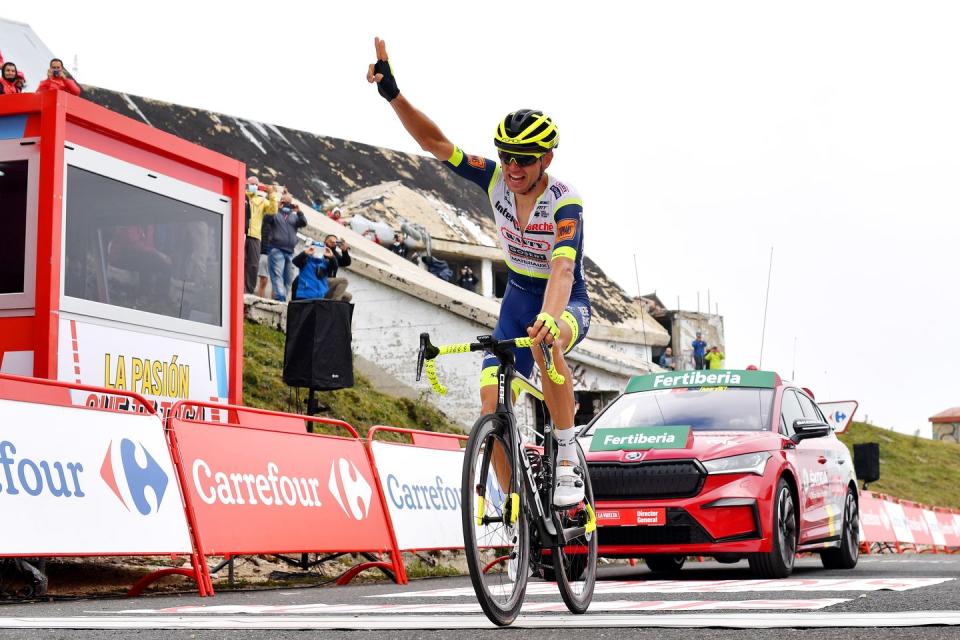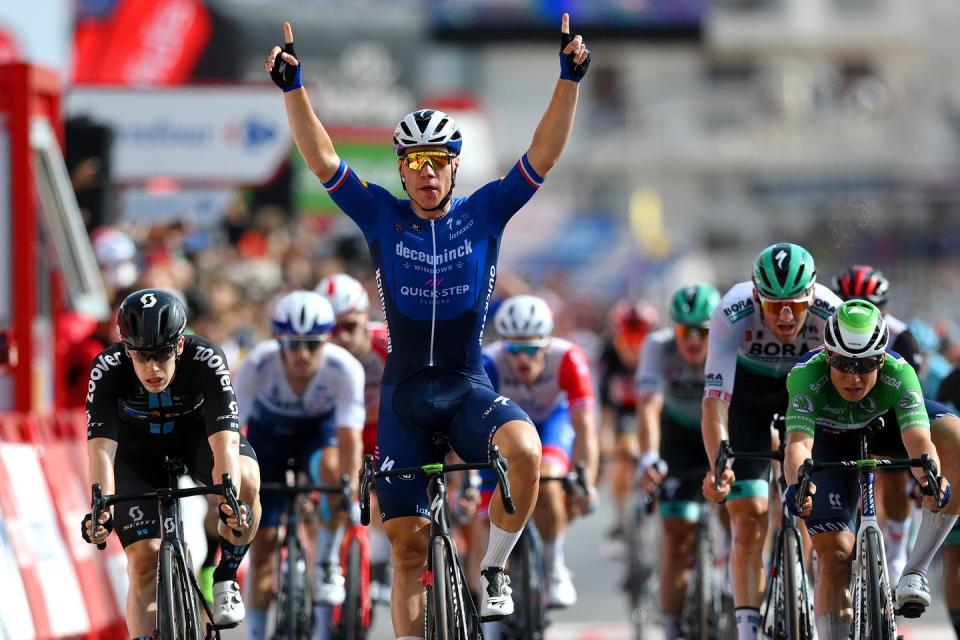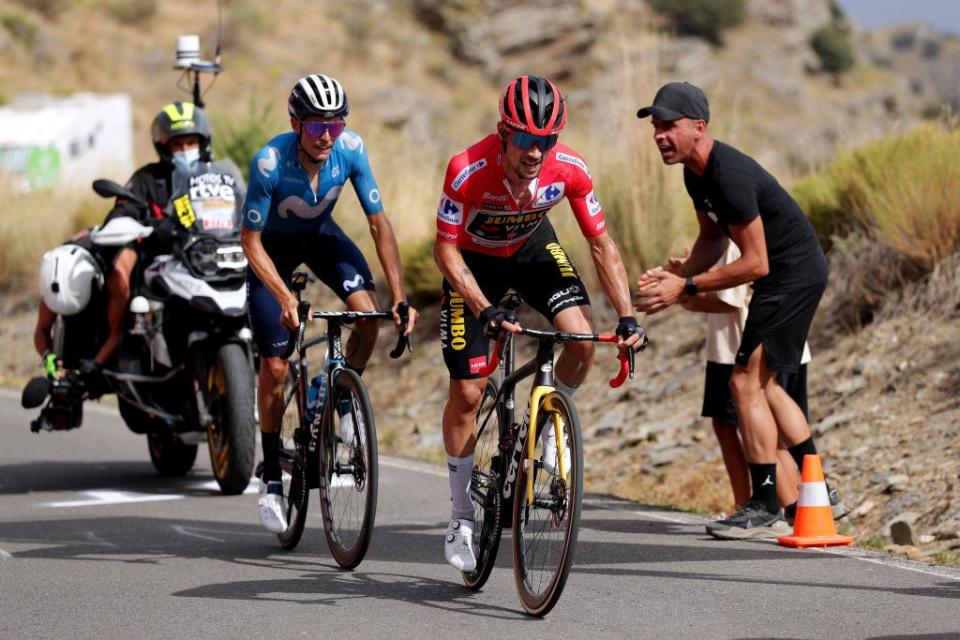Primož Roglič Might Have La Vuelta a España Locked Down

- Oops!Something went wrong.Please try again later.
- Oops!Something went wrong.Please try again later.
We’re nine stages into the 2021 Tour of Spain (known locally as the Vuelta a España), and it’s already shaping up to be one of the most intense races of the season—and not just because of Spain’s late-summer heat.
In case you haven’t been watching, here’s a quick overview of all that’s gone down so far:
Who’s winning?
After nine stages, Slovenia’s Primož Roglič (Jumbo-Visma) wears the red jersey as the overall leader of the Tour of Spain. The two-time defending champion has ridden a perfect race so far, winning the opening time trial and methodically adding to his lead on each of the first week’s four summit finishes.
He leads Spain’s Enric Mas (Movistar) by 28 seconds and Colombia’s Miguel Angel López (Movistar) by 1:21 on the Vuelta’s General Classification.
What happened?
Roglič picked up right where he left off after winning the last two Tours of Spain, winning Stage 1’s 7.1km individual time trial in Burgos. The Olympic champion paced himself well on the Category 3 climb during the first half of the course then powered his way to victory on the flatter second half, defeating Spain’s Alex Aranburu (Astana) by six seconds. But more importantly, Roglič put time into all of his GC rivals, especially Colombia’s Egan Bernal (INEOS Grenadiers) who conceded 26 seconds to the Vuelta’s two-time defending champion.
While the expected crosswinds never really materialized on Stage 2, a crash in the finale saw British contenders Adam Yates (INEOS Grenadiers) and Hugh Carthy (EF Education Nippo) lose 30 seconds, while Belgium’s Jasper Philipsen (Alpecin-Fenix) won the field sprint in Burgos. Roglič finished safely with the bunch to retain the red jersey.

Stage 3 brought the Vuelta’s first summit finish, with Estonia’s Rein Taaramäe (Intermarché-Wanty-Gobert Matériaux) dropping his breakaway companions Joe Dombrowski (UAE Team Emirates) and Kenny Elissonde (Trek-Segafredo) to win the stage atop the Picón Blanco and take the red jersey as the Vuelta’s new overall leader. Behind Taaramäe, the GC battle continued to evolve with Mas gaining three seconds on a group containing Roglič, Bernal, and Spain’s Mikel Landa (Bahrain-Victorious), while Carthy, France’s Romain Bardet (Team DSM), Russia’s Aleksandr Vlasov (Astana), and Ecuador’s Richard Carapaz (INEOS-Carapaz) all lost time.
The next day, Dutchman Fabio Jakobsen (Deceuninck-Quick Step) sprinted to victory at the end of Stage 4 in Molina de Aragón, almost a year after a life-threatening crash at the Tour of Poland almost ended his career. Taaramäe crashed 2km from the finish line, but held onto the red jersey since the fall occurred inside 3km to go. More crashes punctuated the end of Stage 5, with a pile-up 11km from the finish in Albacete taking down Taaramäe (again) and Bardet. Taaramäe was unable to rejoin the leaders, so Elissonde took the red jersey as the Vuelta’s overall leader while Philipsen won his second stage of the race.
The Vuelta’s second summit finish came at the end of Stage 6, with Denmark’s Magnus Cort (EF Education Nippo) barely holding on from the day’s breakaway to take the stage victory over Roglič, who took back the red jersey and put a bit more time into his rivals with a surge a few hundred meters from the finish line atop the Alto de la Montaña de Cullera.
Stage 7 covered six categorized climbs and ended with another summit finish. The stage went to Australia’s Michael Storer (Team DSM), who (like Cort the day before) survived from the day’s breakaway to take the win atop the Balcón de Alicante while the GC battle waged behind him. Roglič and Jumbo-Visma survived the tricky stage and managed to add a few more seconds to the Slovenian’s advantage, but others weren’t so lucky: Carthy, last year’s third-place finisher, and Spain’s Alejandro Valverde (Movistar), who won the race in 2009, both abandoned the race.
Stage 8 offered a bit of respite to the tired peloton, with Jakobsen winning his second stage at the end of a flat ride from Santa Pola to La Manga del Mar Menor. The Dutchman’s second stage victory gave him the lead in the Vuelta’s Points Classification.

The first “week” ended with a mountain stage finishing atop the “Beyond Category” Alto de Velefique, the hardest summit finish so far in this year’s race. Italy’s Daminao Caruso (Bahrain Victorious), the runner-up in May’s Giro Italia, won the stage and with it took the lead in the Vuelta’s King of the Mountains Classification.
But the real action took place further down the road, where Roglič and Mas pulled away from a select group of GC contenders that included Bernal. Once dropped, the Colombian proved unable to stay with the remnants of this small group and found himself losing 1:05 to Roglič by the end of the stage. Other pre-race contenders fared much worse, with Vlasov losing 2:43, Landa losing 3:59, and Carapaz 8:03 to the Slovenian.
What did we learn?
At May’s Giro d’Italia and July’s Tour de France, the rider who went into the first Rest Day wearing the race leader’s jersey (Bernal and Slovenia’s Tadej Pogačar) went on to win the race overall. And given how he raced during the Vuelta’s first nine stages, there’s little reason to think Roglič won’t do the same.
His biggest challenge should come from Movistar, with Mas and López sitting second and third overall. Both talented climbers, these two could give Roglič a hard time in the mountains that come during the Vuelta’s second and third weeks, especially if the Slovenian, who won the Olympic time trial in late July, has hit his peak a bit too soon.
Then again, this is Movistar, a team known for its poor tactics despite often coming to grand tours with multiple cards to play. Both Mas and López have finished on the Vuelta’s final podium in the past, and their ability to cooperate will be the key to their team’s success—or demise.

Bernal is the race’s biggest question mark. The Colombian sits 1:52 behind the red jersey, which isn’t insurmountable given the mountains to come. But his team lacks cohesion, as evidenced by the fact that Yates didn’t wait for Bernal when he was dropped on the Alto de Velefique at the end of Stage 9.
Yates is a strong rider and a solid contender for a top-10 finish overall--but he’s no Egan Bernal and there’s little reason why he didn’t help Bernal limit his losses. With Bernal, Yates, Carapaz, and Russia’s Pavel Sivakov (who’s shown himself to be in great shape while riding in a supporting role), the British superteam has more than enough talent, but without a clear leader or a designated hierarchy as to who does what and when, they’ll stand little chance of threatening Roglič and the red jersey.
What’s next?
Truth be told, the Vuelta’s second week is probably the “easiest” of the three. It begins with three transition stages which should favor breakaways, while also offering opportunities for GC skirmishes that could produce a surprise or two. For example, Stages 11 and 13 each end with a Category 2 climb inside the final 20km, and Stage 12 has a Category 2 climb followed by a super-steep climb to the finish line in Valdepeñas de Jaén. Anyone having a bad day could lose more time on these challenging finishes, especially if Roglič senses weakness in his challengers.
Stage 14 is a long one (203km) and should end with a field sprint in Villanueva de la Serena, setting up a dramatic weekend featuring two days in the mountains: Stage 14, a shorter stage with a summit finish atop the Pico Villuercas (14.5km at 6.2%), and Stage 15, a long stage (197.5km) with four categorized climbs, the last of which comes only 5km from the finish line in El Barraco. These aren’t stages that will blow the race apart, instead expect to see riders try and gain time in small amounts, similar to the manner in which Roglič built his lead during the first week.
This week should be even hotter than the first, as the race hits its southernmost point before heading inland into Extremadura and Castilla y León, where temperatures will really start to soar. An early start date has already made this Vuelta hotter than most, and it’s only going to get worse as the race works its way toward its final week along the northern Atlantic coast of the Iberian Peninsula.
You Might Also Like

